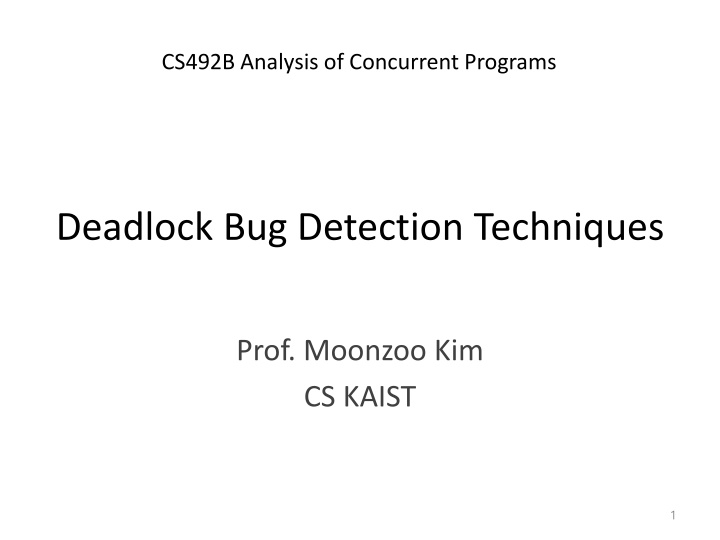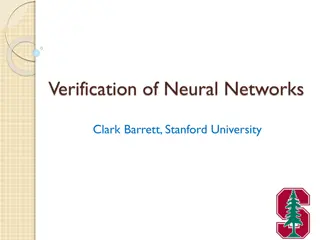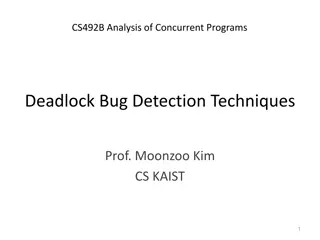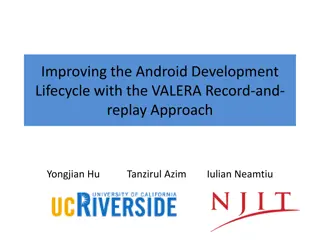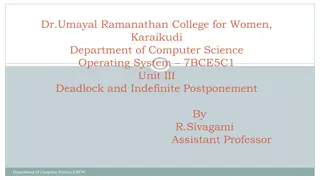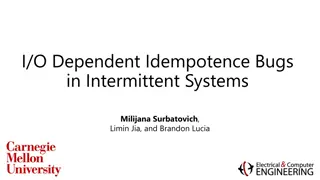Discovering Techniques for Detecting Deadlock Bugs in Concurrent Programs
This analysis delves into various bug detection techniques for concurrent programs, focusing on deadlock bugs. It explores model checking and testing techniques, discussing their precision, error detection capabilities, and scalability challenges. The prevalence of deadlock bugs in real-world applications is highlighted, underlining the importance of effective bug detection methods. Additionally, examples such as the dining philosopher problem illustrate resource deadlock scenarios in concurrent programs.
Download Presentation

Please find below an Image/Link to download the presentation.
The content on the website is provided AS IS for your information and personal use only. It may not be sold, licensed, or shared on other websites without obtaining consent from the author.If you encounter any issues during the download, it is possible that the publisher has removed the file from their server.
You are allowed to download the files provided on this website for personal or commercial use, subject to the condition that they are used lawfully. All files are the property of their respective owners.
The content on the website is provided AS IS for your information and personal use only. It may not be sold, licensed, or shared on other websites without obtaining consent from the author.
E N D
Presentation Transcript
CS492B Analysis of Concurrent Programs Deadlock Bug Detection Techniques Prof. Moonzoo Kim CS KAIST 1
Bug Detection Techniques for Concurrent Programs Model checking techniques + High precision + Comprehensive error detection - Scalability (state explosion problem) - Verification expertise is required test cases and thread schedules executions) - False alarms Testing techniques + High precision + Friendly to developers - Difficult to generate (no need to generate many Verification Bug detection techniques + Fast and convenient SPIN jCute Fusion Java PathFinder CHESS Precision KISS CalFuzzer ConTest rstest Atomizer Eraser RacerX MetaL False alarm 100~1,000 LOC 1,000,000 LOC < Scalability 2 CS492B Analysis of Concurrent Programs, Prof. Moonzoo Kim
Deadlock Bugs Frequently Occur in Real World In a survey on 105 real-world concurrency bugs in open- source applications, 31 out of 105 bugs are deadlock bugs [Lu et al., ASPLOS 08] 3 CS492B Analysis of Concurrent Programs, Prof. Moonzoo Kim
Deadlock Bugs Frequently Occur in Real World According to Apache bug tracking systems, there have been 200 deadlock related issues since 2014 4 CS492B Analysis of Concurrent Programs, Prof. Moonzoo Kim
Deadlock A deadlock occurs when each of a set of threads is blocked, waiting for another thread in the set to satisfy certain condition release shared resource raise event 5 CS492B Analysis of Concurrent Programs, Prof. Moonzoo Kim
Resource Deadlock Ex. Dining philosopher problem 1. Think 2. If left fork is available, pick it up 3. If right fork is available, pick it up 4. Eat 5. Put the right folk down 6. Put the left folk down [Milner] [Dijkstra] [Milner] [Dijkstra] Folk#1 Pick up Folk#1 Pick up Folk#1 Pick up Folk#2 Pick up Folk#2 Wait for Folk#2 Folk#2 Pick up Folk#2 Wait for Folk#1 Pick up Folk#1 6 CS492B Analysis of Concurrent Programs, Prof. Moonzoo Kim
Resource Deadlock in Concurrent Programs ABBA deadlock Thread1() { 1: lock(X) 2: x = ; 3: lock(Y) 4: y = ; 5: unlock(Y) 6: unlock(X) } Thread2() { 11: lock(Y) 12: y = ; 13: lock(X) 14: x = ; 15: unlock(X) 16: unlock(Y) } t1: Thread 1 t2: Thread 2 1:lock(X) 2:x = 11:lock(Y) 12:y=... 3:lock(Y) 13:lock(X) 7 CS492B Analysis of Concurrent Programs, Prof. Moonzoo Kim
Excerpt from the wikipedia Non-blocking Algorithm An algorithm is called non-blocking if failure or suspension of any thread cannot cause failure or suspension of another thread a non-blocking algorithm is lock-free if there is guaranteed system-wide progress, and wait-free if there is also guaranteed per-thread progress. Blocking a thread is undesirable for many reasons while non-blocking algorithms do not suffer from these downsides while the thread is blocked, it cannot accomplish anything certain interactions between locks can lead to error conditions such as deadlock, livelock, and priority inversion. using locks involves a trade-off between coarse-grained locking, which can significantly reduce opportunities for parallelism, and fine-grained locking, which requires more careful design, increases locking overhead and is more prone to bugs. 8 CS492B Analysis of Concurrent Programs, Prof. Moonzoo Kim
Communication Deadlock Lost notify Thread1() { 1: ... 2: for(i=0;i<10;i++){ 3: wait(m) ;} } Thread2() { 11: ... 12: for(j=0;j<10;j++){ 13: notify(m);} } t2: Thread 2 t1: Thread 1 3:wait(m)//i==0 13:notify(m)//j==0 13:notify(m)//j==9 (terminate) 3:wait(m)//i==9 9 CS492B Analysis of Concurrent Programs, Prof. Moonzoo Kim
Excerpt from the Java reference manual public final void wait() Causes the current thread to wait until another thread invokes the notify() method or the notifyAll() method for this object. The current thread must own this object's monitor. The thread releases ownership of this monitor and waits until another thread notifies threads waiting on this object's monitor to wake up either through a call to the notify method or the notifyAll method. The thread then waits until it can re-obtain ownership of the monitor and resumes execution. Interrupts and spurious wakeups are possible, and this method should always be used in a loop: synchronized (obj) { while (<condition does not hold>) obj.wait(); ... // Perform action appropriate to condition } See the following stackoverflow discussion: http://stackoverflow.com/questions/105059 2/do-spurious-wakeups-actually-happen 10 CS492B Analysis of Concurrent Programs, Prof. Moonzoo Kim
Excerpt from the Java reference manual public final void notify() Wakes up a single thread that is waiting on this object's monitor. If any threads are waiting on this object, one of them is chosen to be awakened. The choice is arbitrary and occurs at the discretion of the implementation. The awakened thread will not be able to proceed until the current thread relinquishes the lock on this object. The awakened thread will compete in the usual manner with any other threads that might be actively competing to synchronize on this object; for example, the awakened thread enjoys no reliable privilege or disadvantage in being the next thread to lock this object. This method should only be called by a thread that is the owner of this object's monitor. A thread becomes the owner of the object's monitor in one of three ways: By executing a synchronized instance method of that object. By executing the body of a synchronized statement that synchronizes on the object. For objects of type Class, by executing a synchronized static method of that class. 11 CS492B Analysis of Concurrent Programs, Prof. Moonzoo Kim
Finding Deadlock Bugs is Difficult A deadlock bug induces deadlock situations only under certain thread schedules Systems software creates a massive number of locks for fine-grained concurrency controls Function caller-callee relation complicates the reasoning about possible nested lockings 12 CS492B Analysis of Concurrent Programs, Prof. Moonzoo Kim
Bug Detection Approach Resource deadlock Basic potential deadlock detection algorithm GoodLock algorithm Communication deadlock CHECKMATE: a trace program model-checking technique for deadlock detection 13 CS492B Analysis of Concurrent Programs, Prof. Moonzoo Kim
Basic Potential Deadlock Detection Extend the cyclic deadlock monitoring algorithm Cyclic deadlock monitoring algorithm (e.g. LockDep) Monitor lock acquires and releases in runtime Lock graph (N, EN) Create a node nXwhen a thread acquires lock X Create an edge (nX, nY) when a thread acquires lock Y while holding lock X Remove nX, (nX,*) and (*, nX) when a thread releases X Report deadlock when the graph has any cycle 14 CS492B Analysis of Concurrent Programs, Prof. Moonzoo Kim
Cyclic Deadlock Detection Example (1/2) Thread1() { 1: lock(X) 2: a = ; 3: lock(Y) 4: b = ; 5: unlock(Y) 6: unlock(X) } Thread2() { 11: lock(Y) 12: b = ; 13: lock(X) 14: a = ; 15: unlock(X) 16: unlock(Y) } t1: Thread 1 t2: Thread 2 1:lock(X) 2:a = 11:lock(Y) 12:b=... 3:lock(Y) 13:lock(X) 3 X Y Deadlock detected! 13 15 CS492B Analysis of Concurrent Programs, Prof. Moonzoo Kim
Cyclic Deadlock Detection Example (2/2) t1: Thread 1 1:lock(X) 2:a = 3:lock(Y) 4:b = 5:unlock(Y) t2: Thread 2 Thread1() { 1: lock(X); 2: a = 3: lock(Y); 4: b = 5: unlock(Y); 6: unlock(X); } Thread2() { 11: lock(Y); 12: b = 13: lock(X); 14: a = 15: unlock(X); 16: unlock(Y); } 11:lock(Y) 6:unlock(X) 12:b =... 13:lock(X) 14:a =... 15:unlock(X) 16:unlock(Y) 3 XX X YYY No problem X Y 13 16 CS492B Analysis of Concurrent Programs, Prof. Moonzoo Kim
Basic Deadlock Prediction Technique Potential cyclic deadlock detection algorithm [Harrow, SPIN 00] Lock graph (N, EN) Create a node nXwhen a thread acquires lock X Create an edge (nX, nY) when a thread acquires lock Y while holding lock X Remove nX, (nX,*) and (*, nX) when a thread releases X Report potential deadlocks if the resulted graph at the end of an execution has a cycle [Harrow, SPIN 00] J. J. Harrow, Jr.: Runtime checking of multithreaded applications with Visual Threads, SPIN Workshop 2000 17 CS492B Analysis of Concurrent Programs, Prof. Moonzoo Kim
Potential Cyclic Deadlock Detection Example t1:Thread 1 1:lock(X) 2:a = 3:lock(Y) 4:b = 5:unlock(Y) t2:Thread 2 Thread1() { 1: lock(X) 2: a = ; 3: lock(Y) 4: b = ; 5: unlock(Y) 6: unlock(X) } Thread2() { 11: lock(Y) 12: b = ; 13: lock(X) 14: a = ; 15: unlock(X) 16: unlock(Y) } 11:lock(Y) 6:unlock(X) 12:b=... 13:lock(X) ... 3 X Y Cycle Potential deadlock 13 18 CS492B Analysis of Concurrent Programs, Prof. Moonzoo Kim
Basic Deadlock Prediction Technique The algorithm is commercialized as a SW tool VisualThreads (HP) Empirical results show that the algorithm is very effective to discover hidden deadlock bugs Challenge: generate many false positive 19 CS492B Analysis of Concurrent Programs, Prof. Moonzoo Kim
False Positive Example#1 Single Thread Cycle 2 Thread1() { 1: lock(X); 2: lock(Y); 3: unlock(Y); 4: unlock(X); Thread2() { 11: lock(X); 12: unlock(X); X Y 13: lock(Y); 14: unlock(Y);} 5 The lock graph has a cycle, but no deadlock 5: lock(Y); 6: lock(X); 7: unlock(X); 8: unlock(Y);} A cycle that consists of edges created by one thread is a false positive 20 CS492B Analysis of Concurrent Programs, Prof. Moonzoo Kim
False Positive Example#2: Gate Lock Thread1() { 1: lock(X); 2: lock(Y); 3: lock(Z) ; 4: unlock(Z); 5: unlock(Y); 6: unlock(X); } Thread2() { 11: lock(X); 12: lock(Z) ; 13: lock(Y) ; 14: unlock(Y); 15: unlock(Z); 16: unlock(X); Gate lock (guard lock) Cycle, but no deadlock 3 Y 2, 13 13 X Z 3, 12 21 CS492B Analysis of Concurrent Programs, Prof. Moonzoo Kim
False Positive Example#3: Thread Creation Thread segment#1 Thread segment#2 main(){ 0: start(f1); } f1(){ 1: lock(X); 2: lock(Y); 3: unlock(Y); 4: unlock(X); 5: start(f2); } 2 f2(){ 11: lock(Y) ; 12: lock(X); 13: unlock(X); 14: unlock(Y); } Cycle, but no deadlock X Y 12 22 CS492B Analysis of Concurrent Programs, Prof. Moonzoo Kim
GoodLock Algorithm[Agarwal, IBM 10] Extend the lock graph in the basic potential deadlock detection algorithm to consider thread, gate lock, and thread segment Thread segment graph (S, ES) When the main thread t0starts: Create a thread segment node s0; map t0to s0 (M(t0) = s0); n = 1. When a thread tistarts a new thread tj Create two thread segment nodes snand sn+1 ; Create two edges (M(ti), sn) and (M(ti), sn+1) ; M(ti) = sn; M(tj) = sn+1 ; n = n + 2 ; [Agarwal, IBM 10] R. Agarwal et al., Detection of deadlock potential in multithreaded programs, IBM Journal of Research and Development, 54(5), 2010 CS492B Analysis of Concurrent Programs, Prof. Moonzoo Kim 23
Thread Segment Graph Example t0: main() t1: f1() t2: f2() main(){ 0: 1: start(f1); 2: } s0 s1 s2 f1(){ 1: lock(X); 2: lock(Y); 3: start(f2); 4: unlock(Y); 5: unlock(X);} s4 s3 f2(){ 11: lock(Y) ; 12: lock(X); 13: unlock(X); 14: unlock(Y); s4 s0 s2 s1 s3 24 CS492B Analysis of Concurrent Programs, Prof. Moonzoo Kim
Extended Lock Graph Lock graph (N, EN) Create a node nXwhen a thread acquires lock X Create an edge (nX, L, nY) when a thread acquires lock Y while holding lock X, where L = (s1, t, G, s2) s1: the thread segment (s1 S) where lock X was acquired t: the thread that acquires lock Y G: the set of locks that t holds when it acquires Y s2: the thread segment where lock Y was acquired 25 CS492B Analysis of Concurrent Programs, Prof. Moonzoo Kim
Potential Deadlock Detection A cycle is valid (i.e., true positive) when every pair of edges (m11, (s11, t1, G1, s12), m12), and (m21, (s21, t2, G2, s22), m22) in the cycle satisfies: ?1 ?2, and ?1 ?2= , and (?12 ?21) The happens-before relation is the transitive closure of the relation R such that ?1,?2 ? if there exists the edge from ?1 to ?2 in the thread segment graph 26 CS492B Analysis of Concurrent Programs, Prof. Moonzoo Kim
Thread Creation Example Revisit t0: main() t1: f1() t2: f2() main(){ 0: 1: start(f1); 2: } s0 s1 s2 f1(){ 1: lock(X); 2: lock(Y); 3: start(f2); 4: unlock(Y); 5: unlock(X);} s4 s3 f2(){ 11: lock(Y) ; 12: lock(X); 13: unlock(X); 14: unlock(Y); e1: (nX, (s2, t1, {X}, s2), nY) X Y s4 s0 s2 e2: (nY, (s4, t2, {Y}, s4), nX) s1 s3 27 CS492B Analysis of Concurrent Programs, Prof. Moonzoo Kim
Revising Singe Thread Cycle Example Thread1() { 11: lock(X); 12: lock(Y); 13: unlock(Y); 14: unlock(X); Thread2() { 21: lock(X); 22: unlock(X); main() { 1: start(Thread1); 2: start(Thread2); } 23: lock(Y); 24: unlock(Y);} 15: lock(Y); 16: lock(X); 17: unlock(X); 18: unlock(Y);} e1: (nX, (s2, t1,{X}, s2), nY) s0 s2 X Y s1 s4 s3 e2: (nY, (s2, t1, {Y}, s2), nX) 28 CS492B Analysis of Concurrent Programs, Prof. Moonzoo Kim
Revising Gate Lock Example main() { start(Thread1); start(Thread2); } Thread1() { 1: lock(X); 2: lock(Y); 3: lock(Z) ; 4: unlock(Z); 5: unlock(Y); 6: unlock(X); } Thread2() { 11: lock(X); 12: lock(Z) ; 13: lock(Y) ; 14: unlock(Y); 15: unlock(Z); 16: unlock(X); Y e1: (nY, (s2, t1, {X, Y}, s2), nZ) s0 s2 e2: (nZ, (s4, t2, {X, Z}, s4), nZ) s1 s4 X Z s3 29 CS492B Analysis of Concurrent Programs, Prof. Moonzoo Kim
Detecting Potential Deadlock with Wait/Notify, Semaphore, etc* class BlockedBuffer { List buf = new ArrayList(); int cursize = 0; int maxsize; sync void put(Object e){ while(isFull()) wait() ; buf.add(e); cursize++ ; notify(); } BlockedBuffer(int max){ maxsize = max; } Object get(){ Object e; sync(this){ while(isEmpty()) wait() ; e = buf.remove(0); if(isFull()){ cursize--; notify(); } else cursize--; } return e; } sync boolean isFull(){ return(cursize>=maxsize); } sync boolean isEmpty(){ return(cursize == 0) ; } sync void resize(int m){ maxsize = m; } *P. Joshi et al., An Effective Dynamic Analysis for Detecting Generalized Deadlocks, FSE 2010 30 CS492B Analysis of Concurrent Programs, Prof. Moonzoo Kim
Correct Execution Scenario main() { BoundedBuffer bf = new BoundedBuffer(1); (new Thread1(bf)).start(); (new Thread2(bf)).start(); (new Thread3(bf)).start();} Thread1 Thread2 Thread3 bf.put(0) bf.resize(10) Thread1(BoundedBuffer bf){ bf.put(0); bf.put(1);} bf.put(1) bf.get() Thread2(BoundedBuffer bf){ bf.resize(10);} Thread3(BoundedBuffer bf){ bf.get();} 31 CS492B Analysis of Concurrent Programs, Prof. Moonzoo Kim
Another Correct Execution Scenario main() { BoundedBuffer bf = new BoundedBuffer(1); (new Thread1(bf)).start(); (new Thread2(bf)).start(); (new Thread3(bf)).start();} Thread1 Thread2 Thread3 while(isFull()) wait(); bf.put(0) bf.put(1) if(isFull()) { notify() ; } Thread1(BoundedBuffer bf){ bf.put(0); bf.put(1);} bf.get() bf.put(1) Thread2(BoundedBuffer bf){ bf.resize(10);} bf.resize(10) Thread3(BoundedBuffer bf){ bf.get();} 32 CS492B Analysis of Concurrent Programs, Prof. Moonzoo Kim
Deadlock Execution Scenario main() { BoundedBuffer bf = new BoundedBuffer(1); (new Thread1(bf)).start(); (new Thread2(bf)).start(); (new Thread3(bf)).start();} Thread1 Thread2 Thread3 while(isFull()) wait(); bf.put(0) bf.put(1) Thread1(BoundedBuffer bf){ bf.put(0); bf.put(1);} cursize=1 bf.resize(10) if(isFull()) { notify() ; } Thread2(BoundedBuffer bf){ bf.resize(10);} bf.get() Thread3(BoundedBuffer bf){ bf.get();} 33 CS492B Analysis of Concurrent Programs, Prof. Moonzoo Kim
CHECKMATE: Trace Program Model Checking Observe a multi-threaded program execution Retain only the synchronization operations observed during execution Throw away all other operations like memory update and method calls Create a program from the retained operations (trace program) Model checking trace program Check partial behaviors 34 CS492B Analysis of Concurrent Programs, Prof. Moonzoo Kim
Trace Program Example main() { bf = Lock(); isFull=false; start(t1); start(t2); start(t3);} bf.resize() t2() { lock(bf); isFull=false; unlock(bf); } Thread1 Thread2 Thread3 bf.put(0) bf.put(0) t1() { lock(bf) ; if(isFull) wait(bf) ; isFull=true; notify(bf) ; unlock(bf); bf.put(1) bf.get() t3() { lock(bf) ; if(isFull) notify(bf); unlock(bf); } bf.put(1) bf.get() bf.resize(10) lock(bf); if(isFull) wait(bf) ; notify(bf); unlock(bf);} 35 CS492B Analysis of Concurrent Programs, Prof. Moonzoo Kim
